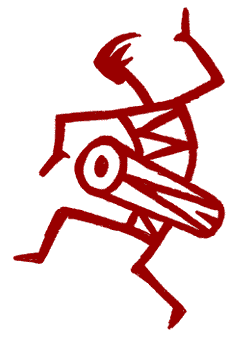

Thought of the Week Archives |
 |

|
|
|
August 19, 2002 Acting Out: Recognizing the Problem Most people seek therapy or healing because (1) they feel bad and want to feel better and/or (2) they recognize that their behaviour patterns are stagnant, destructive, or extreme. Those who are motivated mainly by the first reason are less likely to understand why it is that they feel bad. They just know that they feel bad and want someone else to help them feel better. Those who are motivated by the second reason understand that their behaviours are out of balance. By seeking therapy, they are recognizing a problem and taking some responsibility for it. Recognizing the problem is a large part of the healing process. This may seem obvious, but many of us avoid that realization by blaming the problem on sources outside ourselves. Even though many original causes are outside ourselves, the problem resides in us now, and we have to accept that if we want healthy change to occur. 2500 years ago, in chapter 71 of the Tao Te Ching, Lao Tzu said:
Only when one recognizes disease as disease On page five of The New Primal Scream: Primal Therapy 20 Years on, (1991) Arthur Janov states: At a certain key juncture, unmet needs for love, shelter, and protection turn into pain, which in turn requires repression. After the split the unreal self continues to act out on the basis of these needs. I call this program "symbolic acting out," trying to obtain fulfillment in symbolic ways. This is the essence of neurosis. Old pains are repressed, then acted out in ways which are unreal and merely symbolic. This is the modern human condition. We are ill, and the neurotic "act" is the symptom. With physical illness, a sore throat is the symptom that leads us, or our doctors, to diagnose that the illness is a bacterial infection. With that knowledge, we can find a healing solution. Without the recognition of the symptom as being something we have, there is little chance for improvement. With emotional illness, recognizing the symptoms is not as easy. Is your constant annoyance the symptom of a problem, or is it because you are being constantly provoked? Is your loneliness a symptom, or is it the reasonable reaction to being single? Are your feelings of failure a symptom, or are you really not good enough? The list is endless. In the April 29, 2002, Thought of the Week, "The Conscious Relationship," I explain:
In the primal community, we call neurotic drives our "stuff." When our stuff gets triggered by our partner's behaviour, we either "act it in," "act it out," or "take it to the mat." When we "act in" we do not express our neurotic pain outwardly and hold it in our bodies. This may cause tension, headaches, and other physical illnesses. When we "act out," we express our stuff at others, "dumping" feelings on them that come from our past imprints. Both acting in and acting out do not directly heal, because the root cause of the pain is not addressed, fully felt in context, and released. We either blame ourselves or blame others. It is essential that we begin to recognize our act-outs (symptoms) before we can engage in the feelings and resolve them. Although recognizing an act-out is mainly an intellectual exercise, it is a crucial step because it allows us to redirect the repressed energy - from dumping and blaming it on others to feeling it in session. How do we recognize an act-out? Although a definitive checklist of potential "act outs" cannot be created, certain guidelines can be useful. In essence, we are attempting to see if our behaviour is excessive for the situation. This is always a subjective judgment, even if we ask the opinions of others. Usually, however, a truly neurotic act will not go undetected by our scrutiny and the feedback of others around us. In the Safe Process Guidelines of the IPA's email support group, acting out is described as "avoiding our feelings and attacking, blaming, 'dumping,' criticizing, judging, shaming, insulting, advising, patronizing, projecting, or using indirect contempt such as sarcasm and ridicule." Although this description indicates quite a few aggressive behaviours, it is not the aggression that is the essential problem. The essential problem - and greatest danger to our health and the health of others - is lack of recognition. If we do not recognize that we are blaming or dumping our unresolved feelings on others, we do not heal. We continue to find fault outside ourselves. We continue our futile search for a solution outside ourselves. Therefore, recognition is the first step to healing. Some say that act-outs cannot be recognized because they are unconscious. Although a certain amount of emotional material is unconscious, it is the rising of act-outs to consciousness that initiates recognition (awareness) and the conscious choice to heal. Healing is a continuum that leads from unconsciousness to consciousness. Primal Integration is the antithesis of neurosis - of acting out. When we take a feeling to the mat, we are recognizing that we can no longer blame it on others in the present. We own our feelings and express them in a responsible way. |